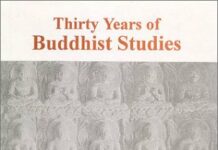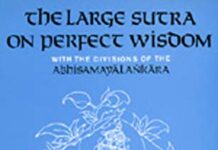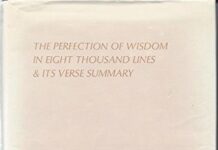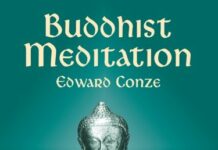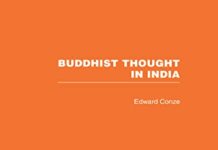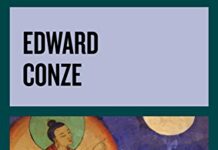
Ebook Info
- Published: 2001
- Number of pages: 160 pages
- Format: PDF
- File Size: 10.38 MB
- Authors: Edward Conze
Description
A landmark publication that offers Western readers a unique combination of what Buddhists worldwide consider the holiest of holy texts, The Diamond Sutra and The Heart Sutra. The Diamond Sutra, or the Perfection of Wisdom, which cuts like a thunderbolt, is one of the cornerstone texts of Mahayana Buddhism and provides a summary of the core concepts of the Buddha. The Heart Sutra, perhaps the most important of all Buddhist texts, sets out to formulate the very heart, or essence of perfect wisdom and is studied with special reverence in Zen monasteries and the Tibetan Buddhist lamaseries. Edward Conze, who was until his death in 1979 a powerful force for introducing Buddhism and its sacred texts to the West, has provided these translated key texts with an extensive commentary for the easiest possible appreciation phrase by phrase. For this new edition, Judith Simmer-Brown, a well-known American scholar of Buddhism, has contributed a lively, context-setting introduction. In the annals of spirituality, certain books stand out both for their historical importance and for their continued relevance. The Vintage Spiritual Classics series offers the greatest of these works in authoritative new editions, with specially commissioned essays by noted contemporary commentators. Filled with eloquence and fresh insight, encouragement and solace, Vintage Spiritual Classics are incomparable resources for all readers who seek a more substantive understanding of mankind’s relation to the divine.
User’s Reviews
Editorial Reviews: Review “The gifted translator Edward Conze’s work has never been surpassed.” —Judith Simmer-Brown From the Back Cover A landmark publication from its first appearance more than forty years ago, Buddhist Wisdom offers Western readers a unique combination of what Buddhists worldwide consider the holiest of holy texts — The Diamond Sutra and The Heart Sutra, or scriptures, ascribed to the early centuries of the first millennium.The Diamond Sutra, or the “Perfection of Wisdom which cuts like a thunderbolt”, is one of the cornerstone texts of Mahayana Buddhism and provides a summary of the core concepts of the Buddha. The Heart Sutra, perhaps the most important of all Buddhist texts, sets out to formulate the very “heart” or essence of perfect wisdom and is studied with special reverence in Zen monasteries and the Tibetan Buddhist lamaseries. About the Author EDWARD CONZE (1904-1970) was born in England but was educated in Germany through postdoctoral studies in Bonn and Hamburg. When Hitler came to power in 1933, Conze returned to England and taught for the better part of three decades, until 1960, at Oxford and London Universities. His subjects included psychology, comparative religion, and philosophy. A lifelong commitment to the translation, explication, and propagation of the classic scriptural texts of Buddhism was the hallmark of his achievement. Read more
Reviews from Amazon users which were colected at the time this book was published on the website:
⭐This is a scholarly work, highly recommended by many, and for great reason. Edward Conze is highly esteemed for his knowledge and wisdom in interpreting Buddhist texts. And in this book he puts together commentary on two of the most important and most diligently studied of all Buddhist texts, the Diamond Sutra and the Heart Sutra. The preface is written by Judith Simmer-Brown, and is wonderfully enlightening in itself, as she explains her own long time study and practice of Buddhism and the significance of this scholarly work by Edward Conze. The commentary, as she states is truly full of wisdom which I will be reading and rereading for many years to come as I continue to try to comprehend these two great Sutras.The only reason I gave it four stars instead of five is that Edward Conze breaks his text down so that the Sutras themselves have to be read in small snippets that go along with his commentaries, so that you cannot read through the Sutras themselves as a whole. Mr. Conze explains to us that he does this for this reason: “Indian tradition assumes that without a commentary a holy book is incomplete. In the case of the Diamond Sutra it is quite obvious that a bare translation cannot possibly convey its full meaning. To the casual reader it must present the disconcerting appearance of a jumble of disjointed pieces, and at first sight the transition from one chapter to the next is not at all obvious. An occasional aphorism here and there may strike the intellect with the force of a thunderbolt, and further meditation may very well fan the initial spark into quite a sizeable flame. But the meaning of the Sutra as a whole is bound to elude him, for it contains within itself only few and inconclusive clues to its logical sequence.”While I don’t question his wisdom in knowing that these texts are difficult for the average person, or lay person to read, other authors such as Thich Nhat Hahn, take the opposite approach, and write out the Sutras so that you can read and reread them in their entirety. Thich Nhat Hahn’s books on these two Sutras are illuminating, and broken down into very logical and easy to follow commentaries, which allow you to go back and reread the entire Sutras again and again, and try to then slowly comprehend them in context of the entire Sutras. His two books are titled, “The Heart of Understanding, Commentaries on the Prajnaparamita Heart Sutra”, as well as his book, “The Diamond That Cuts Through Illusion, Commentaries on the Prajnaparamita Sutra.” I make this point because as a practicing Buddhist I feel it is important to recite and read outloud these Sutras, and while Edward Conze’s book is truly filled with great insight and wisdom, I like it better as a secondary source of study behind Thich Nhat Hahn’s work.I am grateful for Edward Conze’s commentaries and will be rereading them and studying for years to come. And this review is not meant as any slight of this work, merely making a point for anyone looking for books to review these two important Sutras, I would first recommend Thich Nhat Hahn’s commentaries as a first introduction and follow up with this great work by Edward Conze to deepen your understanding.
⭐Informative
⭐I am a Chinese reader of Buddhism and have been reading and learning Buddhist scriptures and their commentaries for many years, reading both Chinese and English sources. And this book, which includes the translation and commentaries of two of the most important scriptures in almost all Mahayana Buddhist Schools, is one of the most clearly-written and well-founded books of them. Its exposition of the meaning of ‘śūnya’ is real to the original Buddhist teaching, at least seen from the angle of Mādhyamika School of Chinese Buddhism. SO, if you want to know the most important message of Mahayana Buddhism, this is the book. By the way, I also highly recommend the author’s another book, Buddhist Meditation.
⭐This book has two parts. Both a very long and can be confusing, but the author is very good at explaining in details. This book can carry a deep meaning if you really look into the text. But it’s still a good read at the end of the day, especially if you had a bad or a sad day, even if you are not looking deep into the meaning of the text.It was also packaged really nicely to ensure that the book got to me in the condition that I’d bought it at.
⭐The forwards and all potentially necessary introductions to this book are the spiritual equivalent of finding the perfect recipe then realizing its written long hand in prose about how the stay at home mom author learned to set up a blog just to tell you the story of how her grandmother learned to make a sandwich.
⭐Buddhism is intellectual, requires a certain capability for open mindedness, yet simple and really straight.forward. Edward Conzes’ translation of these two basic “teachings” of the Buddha are extremely well written providing the novice reader with a basic understanding of their meaning.As with any area in the study of Buddhism, learning is best conducted in a formal teaching environment with a mentor,
⭐this commentary was fine and I am sure the translation of the sutra was well enough. I am just not liking the sutras as much as Buddhist authors that are current. Leaves me to wonder how this scripture came to amazing modern Buddhist authors
⭐Well written and easy to understand.
⭐Beautiful book. Very interesting. Clear. Everyone interested in Buddhism should have this one.
⭐I have never trained as a “proper” Buddhist, and I have also rarely chosen to try meditation. Despite these apparent disadvantages, I can say that this book is deeply involving and a joy to read. It is basically a translation of the two sutras, and that translation is, to my mind, one of the most thorough and careful of any of the great Buddhist scriptures.This is despite the fact this translation was done (by Edward Conze) a number of years ago.I was particularly impressed at the exhaustive way in which each phrase (of the two sutras) was carefully dissected and discussed – this is scholarly work, and made all the more relevant by the great level of care taken in producing it.Anyone who has recently found themselves wondering “what’s it all about”, or “what direction is my life taking” should buy, and read, this book.
⭐Very Buddhist techy stuff. You need to be really into Buddhism to appreciate it or even understand it. But if that’s what you want get it.
⭐Best translation and analysis for a fundamental book on Buddhism.
⭐A very food read!
Keywords
Free Download Buddhist Wisdom: The Diamond Sutra and The Heart Sutra in PDF format
Buddhist Wisdom: The Diamond Sutra and The Heart Sutra PDF Free Download
Download Buddhist Wisdom: The Diamond Sutra and The Heart Sutra 2001 PDF Free
Buddhist Wisdom: The Diamond Sutra and The Heart Sutra 2001 PDF Free Download
Download Buddhist Wisdom: The Diamond Sutra and The Heart Sutra PDF
Free Download Ebook Buddhist Wisdom: The Diamond Sutra and The Heart Sutra
